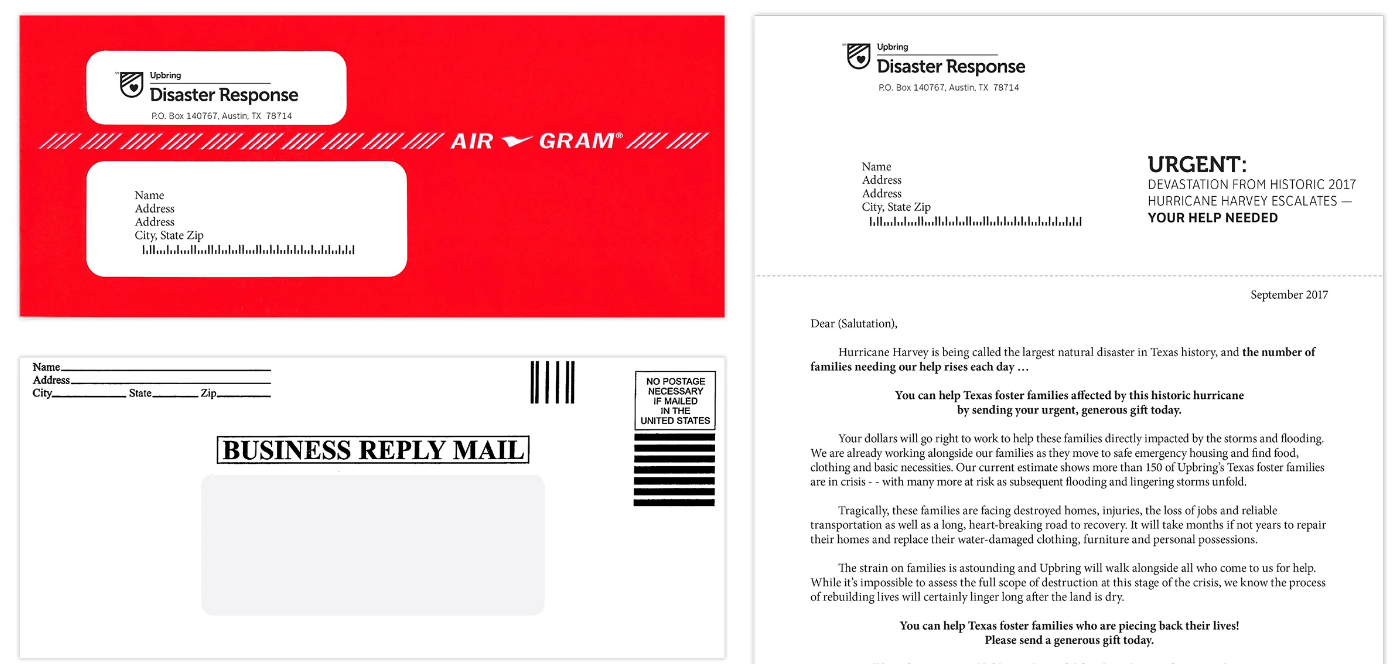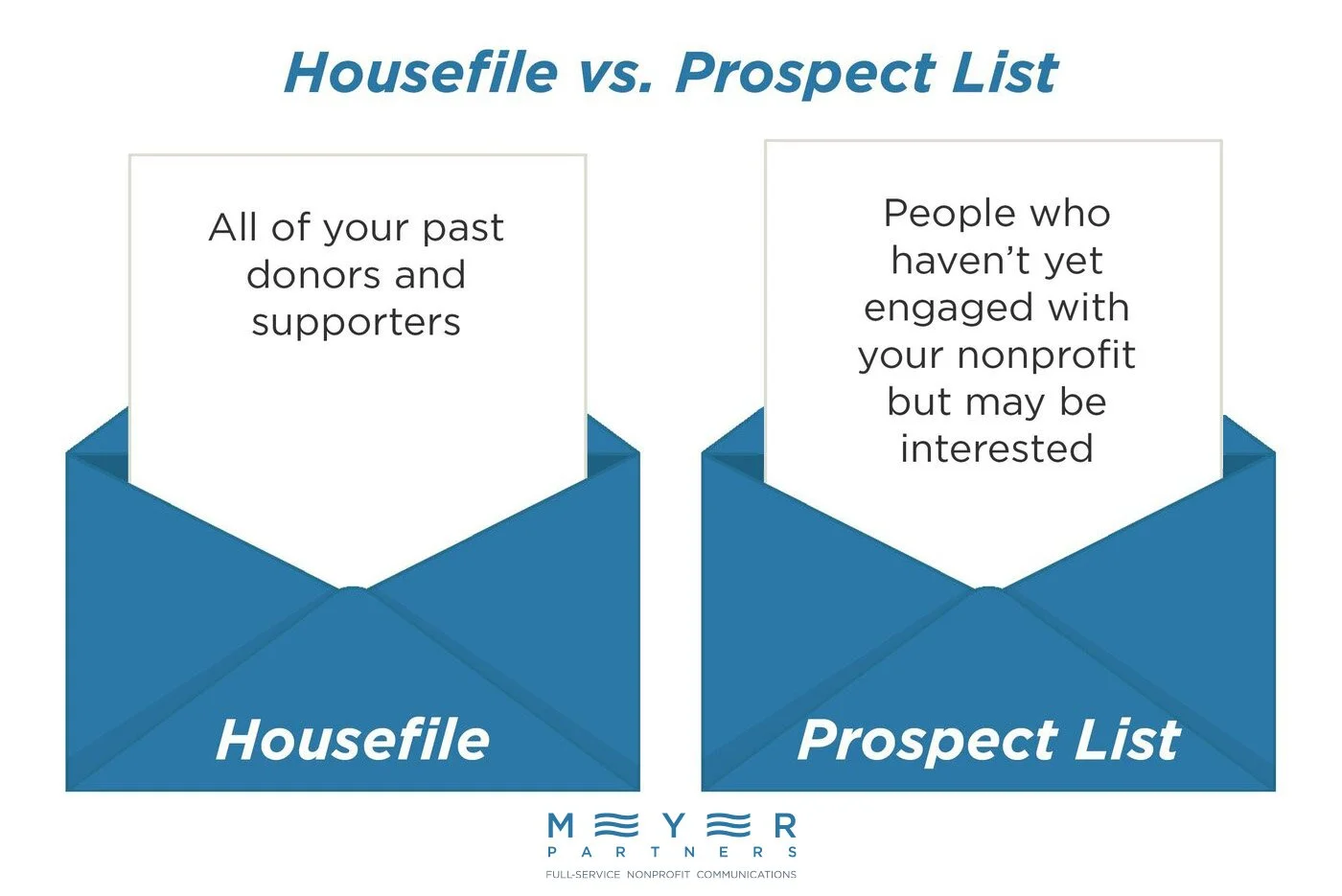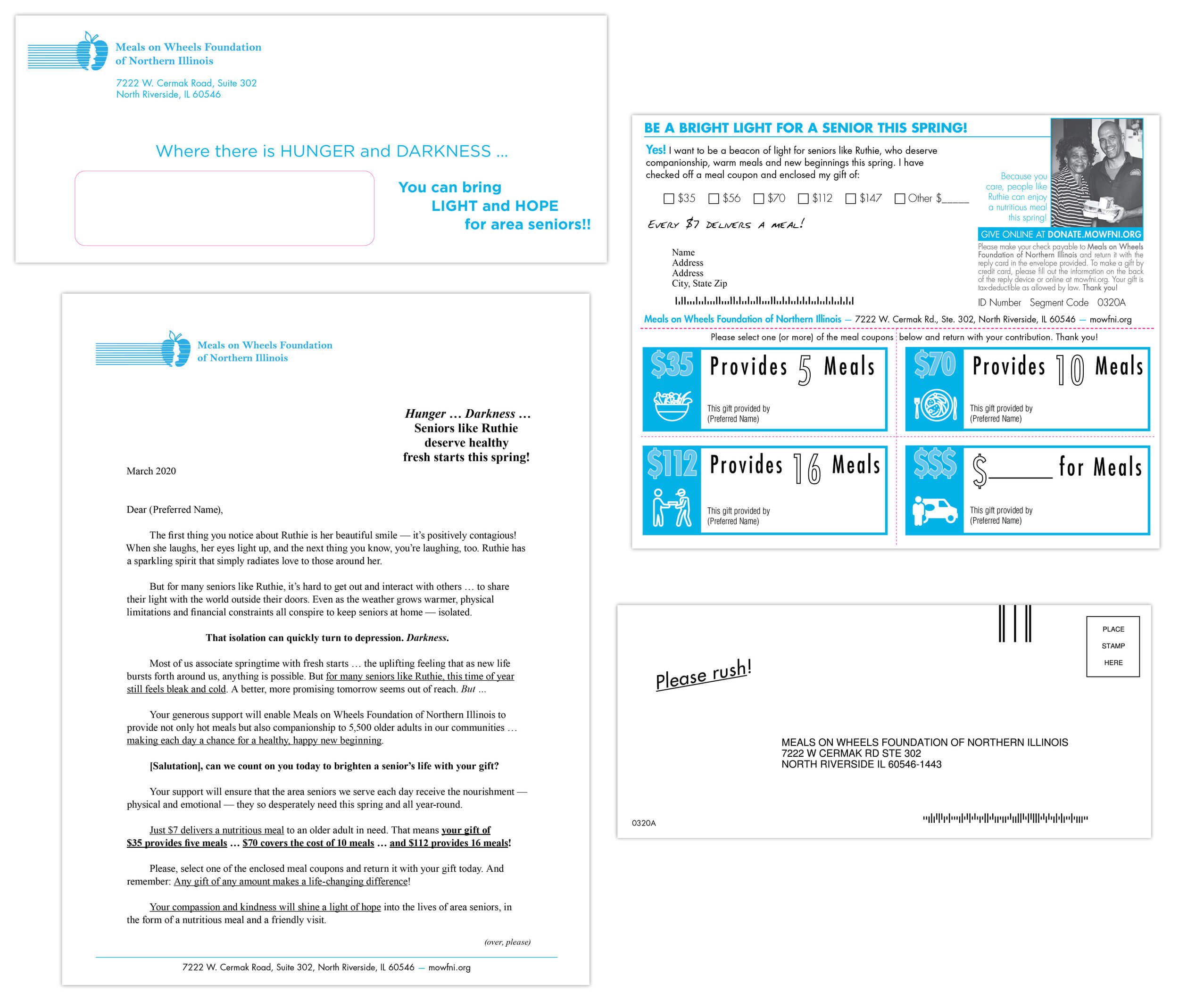How to Succeed with Nonprofit Direct Mail Fundraising
A well-crafted, personalized direct mail appeal is one of the most memorable fundraising communications your nonprofit can send.
In a time when donors are constantly bombarded with emails and online advertisements, direct mail stands out as a personal, heartfelt communication method. Direct mail remains one of the most effective fundraising strategies nonprofits can use to support their missions, but you may not know where to start if you’ve never leveraged this channel before.
In this complete guide to direct mail fundraising for nonprofits, we’ll cover everything you need to know, including:
With the right strategies and support, direct mail fundraising campaigns can boost your donor acquisition rates and deepen your supporter relationships. Let’s go over what you need to know to get started with this impactful fundraising channel.
The Basics of Direct Mail Fundraising
To help you parse through all of the information out there about this tried-and-true fundraising method, let’s start with the basics.
What is nonprofit direct mail fundraising?
Nonprofit direct mail fundraising, also called nonprofit direct marketing, is the process of writing, designing, printing, and distributing hard-copy requests for funds to current and prospective donors. These solicitations arrive in your donors’ mailboxes and provide a tangible, physical connection to your organization.
What are the benefits of nonprofit direct marketing?
As so much of the world has transitioned to the digital space, direct mail has developed a bit of a bad rap. Your nonprofit might speculate about the effectiveness of this “old-fashioned” hard-copy marketing channel. But the reality is that direct mail fundraising campaigns can be incredibly effective at raising money for your organization—even more so than email campaigns.
When done well, direct mail benefits your nonprofit in these key ways:
It feels more personal than email. For many donors, reading emails can feel like work. They may delete them right away to free up space or only glance at the contents before moving on. Direct mail, on the other hand, arrives at their door and feels like a personal message from your nonprofit.
It serves as a tangible reminder of your organization. When donors receive a letter from your nonprofit, they receive a message they can hold in their hands, place on a table, or even post on their fridge. As supporters walk past it day after day, they’ll be reminded of your organization and remember to donate.
Donors like receiving mail. Studies show donors are more likely to respond to a direct mail appeal than an email appeal. Plus, 70% of people agree that they feel more personal and 55% say they look forward to receiving physical mail.
Direct mail is perfect for storytelling. Donors also believe direct mail is better at telling a touching story and conveying facts than digital communication methods. Letters are especially well-suited for sharing short, compelling stories that convince donors to support your cause.
All of these benefits can ultimately help your organization raise more for your mission and cultivate meaningful relationships with donors.
Is direct mail fundraising dead?
No. Direct mail fundraising, when well-targeted to your organization’s audience, is nearly always profitable.
Especially with the rising popularity of USPS Informed Delivery, which allows your recipients to get immediate, digital previews of their incoming mail (with direct links!), there’s never been a better time to tap into the power of direct mail. Your supporters won’t just see your letters—they’ll be excited to receive them at their doorsteps.
When executed as part of a comprehensive strategy, direct mail is an invaluable asset to your nonprofit’s fundraising endeavors. Direct mail fundraising is an effective strategy for any fundraising organization, including nonprofits, schools, museums, and associations.
How effective is direct mail for nonprofits?
According to research by the Data & Marketing Association, the average direct mail response rate is 9%. Compare that to standard email click-through rates of 3.29%, and you’ll see why you should include direct mail in your nonprofit’s fundraising toolkit. Plus, contrary to popular belief, direct mail isn’t only popular with older generations—63% of Gen Z consumers say they’re more excited about direct mail this year than they were last year.
At Meyer Partners, we’ve seen firsthand just how effective nonprofit direct mail fundraising can be. For example, we created this emergency appeal for Upbring after Hurricane Harvey that generated incredible results.
This direct mail appeal saw:
31% higher response rates than their previous appeals
20% increase in their average gift size
60% lower cost per dollar raised than any appeal in four years
These results and countless others prove that direct mail fundraising is effective for engaging donors, inspiring giving, and generating a high return on investment (ROI).
Nonprofit Direct Mail Best Practices
How do you make the most of direct mail and reach your fundraising goals? By following these tried-and-true best practices:
1. Know Your Audience
The first and most essential best practice to follow when crafting a direct mail fundraising strategy is to know your audience. The most basic distinction to consider is: Are you sending appeals to your housefile or a prospect list?
These two lists are defined as:
Your housefile includes all of your past donors and supporters. This list contains people who have demonstrated an interest or a commitment to your cause in the past. When sending appeals to your organization’s housefile, you may be trying to meet a certain fundraising target, steward donors to the next donation tier, or enroll a certain number of donors in a monthly giving program.
A prospect list is a list of people who have not yet engaged with your organization, but who may be willing to. Prospect lists for direct mail campaigns can be purchased, rented, or traded with other nonprofits. In general, the goal of sending out appeals to prospects is to acquire new donors to add to your housefile.
Beyond these general categories, segment your audience further so you can tailor your appeals to specific groups. After all, personalization is the key to establishing a connection with your donors—the more personal your appeals are, the better positioned your organization is to develop real relationships with recipients. Plus, when supporters feel acknowledged as individuals, they are more likely to feel a sense of responsibility to respond.
In fact, studies have found that personalization of fundraising appeals leads to a 5-15% increase in revenue. Adding a person’s name along with other information from your donor database increases response rates by up to 500%.
Once you’ve segmented your housefile into relevant groups, you’ll be able to catch your donors’ attention with personal references and a tailored tone. For instance, longtime donors might appreciate a more friendly, intimate appeal, while donors with past volunteer involvement might appreciate a reference to their volunteer history.
2. Lean on Storytelling
Perhaps the most salient aspect of the direct mail appeal is the personal touch—the letter in the mailbox that ends up in your donor’s hands. The closeness of this interaction presents a wonderful opportunity to connect with donors through storytelling.
Meyer Partners consultants devote a lot of energy to unlocking the power of a story. To tell a powerful story in direct mail appeals, we rely on the three R’s: resonance, relevance, and respect.
Resonance | A story is only as strong as its details
To connect with another person, the story you tell must resonate with them—it must be touching, moving, truthful, honest, passionate, and direct. Tell stories that actually happened, rather than mashups of your constituents’ experiences that don’t ring true.
Talk to people your nonprofit has helped. Write down details. Gather more information than you think you need. Then, when you sit down to write their story, you’ll have a wealth of humanizing details to draw upon to make your appeal as moving as possible.
Relevance | Where does the donor fit into the picture?
Every story must feel relevant to the donor to convince them to act. Use the second-person “you” generously to incorporate the reader into the story, and call upon the reader’s values and ideals. Furthermore, emphasize the impact that a donation can have. This allows the donor to imagine themselves as the hero of the story—which they genuinely are when they contribute to your cause.
Respect | Avoid false urgency, scare tactics, and guilting
In every appeal, respect your donors by being honest and communicating your needs clearly. Avoid insulting the donor or engaging in tactics that could be perceived as manipulative. You don’t need to exaggerate the urgency of your nonprofit’s need or scare donors with shock-value images and stories. You’re writing to engage your donors, not to manipulate them.
3. Connect Copy with Visuals
In an effective direct mail appeal, visual and written elements interact cohesively to reach donors in their hearts and minds—not just their mailboxes.
Include photos and creative design that draw attention to the main points of the appeal, and strategically select images that convey information and reinforce what you’ve said in the copy. Compelling photographs draw donors in and make empathizing with your cause that much easier.
For instance, take a look at the imagery we used for a direct mail fundraising campaign for MAP International, a faith-based organization that provides medicine and health supplies to vulnerable populations:
Our team combined this appeal with personal phone calls, handwritten thank-you notes, welcome packages, and second gift appeals to enhance the power of MAP International’s campaign. In the end, they increased their number of active donors by 9,000—an 85% increase!
4. Set Goals and Measure Impact
Every direct mail fundraising campaign needs a specific goal and tools in place to assess your progress. You’ll also want data analytics capabilities to test your appeals. Analyzing results from various versions of direct mail appeals empowers your organization with information that can point you toward the most successful approach.
For example, you might learn that a specific appeal with these graphics, this story, sent at this time of year, to this audience is wildly successful compared to your average results. You’ll want to implement that appeal—plus the lessons you learned from it—as much as possible to boost your fundraising success.
5. Combine Online and Direct Mail Fundraising
There are so many channels you can use to reach donors these days: direct mail, text, call, email, social media, and more. You don’t have to cover every single channel with every single campaign, but a multichannel approach that combines direct mail and online fundraising tactics is most likely to generate the best results.
Use links and QR codes to seamlessly combine online and offline communication and boost your results across channels. A QR code on a poster, TV ad, or mailer can direct your supporters to online resources such as your online donation form, social media pages, or a fundraising web store.
For example, the team at Meyer Partners created this direct mail appeal for Upbring that highlights both offline and online giving:
In this example, we emphasized that donors have many options for giving in response to the direct mail fundraising appeal: via check, credit card information, or on the nonprofit’s website. If you aren’t sure how to effectively integrate direct mail with your other marketing and fundraising channels, reach out to our marketing experts to learn how we can help.
6. Follow Up Via Mail
Every donor should feel appreciated, no matter the size of their contribution. If a donor gives to your campaign via direct mail, send them a thank-you note in the mail. Make sure these follow-up messages are:
Authentic. Express your heartfelt gratitude by addressing the message from someone the donor knows on your nonprofit’s team. For instance, if they’re a recurring direct mail donor, have the recurring donation program’s officer write the thank-you note. This shows that you’re paying attention to your donors’ connections within your nonprofit.
Handwritten. For your most generous donors, writing thank-you notes by hand can go a long way in strengthening relationships. It reminds donors that your nonprofit is made up of real people like them, committed to furthering their shared interests.
Personal. Include all of the important details that show that your nonprofit cares about the person behind the gift more than anything else. For instance, you might add a note asking the donor about their family or inviting them to an event that aligns with their interests.
Impact-focused. In your thank-you note, illustrate impact by including specifics that highlight the tangible effect of their contribution. For example, you might tell a donor that their gift of $300 has provided a family with meals for two months.
Direct mail allows your team to go the extra mile and express your appreciation for donors in a more heartfelt way. Donors you steward successfully are more likely to convert into repeat donors in the future, so make sure that nobody goes unthanked!
Working with a Direct Mail Fundraising Agency
Outsourcing your organization’s direct mail campaigns to an agency that specializes in nonprofit direct marketing can improve your results while freeing up time for your team to focus on building valuable relationships with donors.
These professionals have extensive knowledge of the nonprofit landscape, the intricacies of donor relationships, and what makes a direct mail appeal impactful. They can work with you through every phase of a direct mail fundraising campaign, from acquiring prospect lists and researching donors to drafting and sending out appeals with powerful copy.
Meyer Partners: Direct Mail Specialists & Full-Service Nonprofit Marketing
At Meyer Partners, our many years of experience in the nonprofit marketing space inform everything we do. We’re a full-service agency, so we offer a complete suite of communications services for nonprofits, but direct mail is an essential aspect of the multichannel approach we take with all of our clients.
We agonize over getting our direct mail campaigns just right. We don’t send generic, cookie-cutter appeals to your supporters, switching out the name of your organization for the last nonprofit we worked with. Instead, we’ll work with you to:
Acquire the best prospect lists.
Analyze your housefile and divide it into effective segments.
Craft specific appeals for each of those segments.
Pore over the writing.
Choose the perfect visuals to accompany the copy.
Design a layout that is aesthetically pleasing and clutter-free.
Send off those powerful letters, ready for your nonprofit to meet (and in many cases, exceed) its fundraising goals.
From there, you can count on Meyer Partners to analyze the campaign’s results with sophisticated tools, extracting useful insights for your future fundraising efforts.
Our Nonprofit Direct Response Campaigns
We’ve worked with countless nonprofit organizations and higher education institutions over the years, and we know what works.
Just take a look at this impactful example of our work for Meals on Wheels:
With this campaign, Meals on Wheels:
Increased their average gift size by 20%.
Dropped their cost to acquire donors by 68%.
Saw a 4% increase in new donors compared to the previous year.
When you work with us, you can count on our 30+ years of experience and expertise to target donors and prospects more effectively than many in-house teams, maximizing return on investment (ROI) for your fundraising campaigns.
Partner with us to develop direct mail fundraising campaigns that help you raise funds and cultivate long-term, impactful donor relationships.
Wrapping Up
Direct mail isn’t—and never was—dead. Donors appreciate the intimacy of a physical letter and often respond positively to your cause presented in a direct mail appeal, more so than they might in an email blast. With effective planning, customization, and implementation, direct mail fundraising can make the difference between missing and exceeding your fundraising goals.
To learn more about nonprofit marketing, explore these additional resources:
Complete Nonprofit Marketing Guide: What to Know. Ready to create an integrated multichannel marketing campaign? Brush up on the basics of all things nonprofit marketing to get started.
Donor Acquisition Guide: 10 Strategies to Attract New Donors. Are you looking to use direct mail to acquire new donors for your organization? Take it a step further by exploring these best practices and strategies for acquiring donors.
Donor Stewardship: How to Create & Use a Stewardship Matrix. Direct mail isn’t just for new donor acquisition. Learn how to leverage the best tools for stewardship and improve your relationships with existing donors.
Alyssa Jefferies
Alyssa Jefferies, MNA, CFRE brings to her role as President of Meyer Partners nearly 20 years of fundraising experience, with a special emphasis on direct response fundraising, stewardship, and mid-level giving. Along with helping nonprofits across the country reach their fundraising and marketing goals, Alyssa serves on the board of the Association of Direct Response Fundraising Counsel (ADRFCO) of The Nonprofit Alliance.












